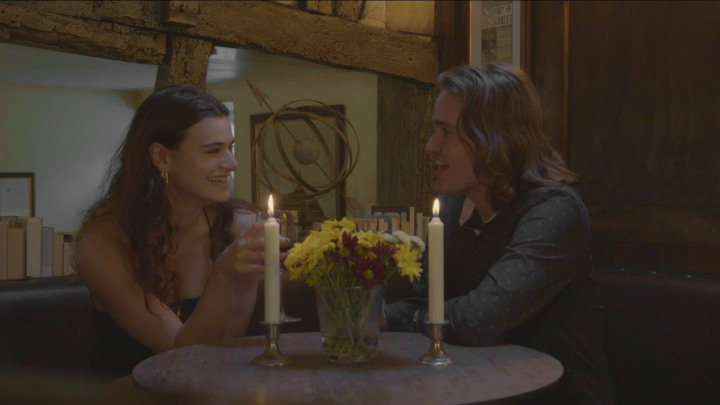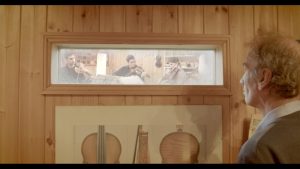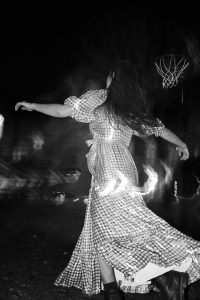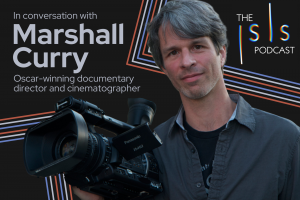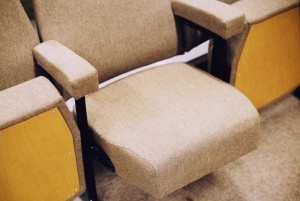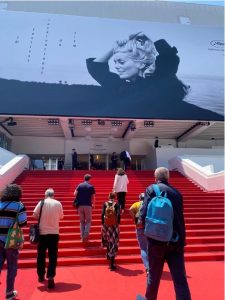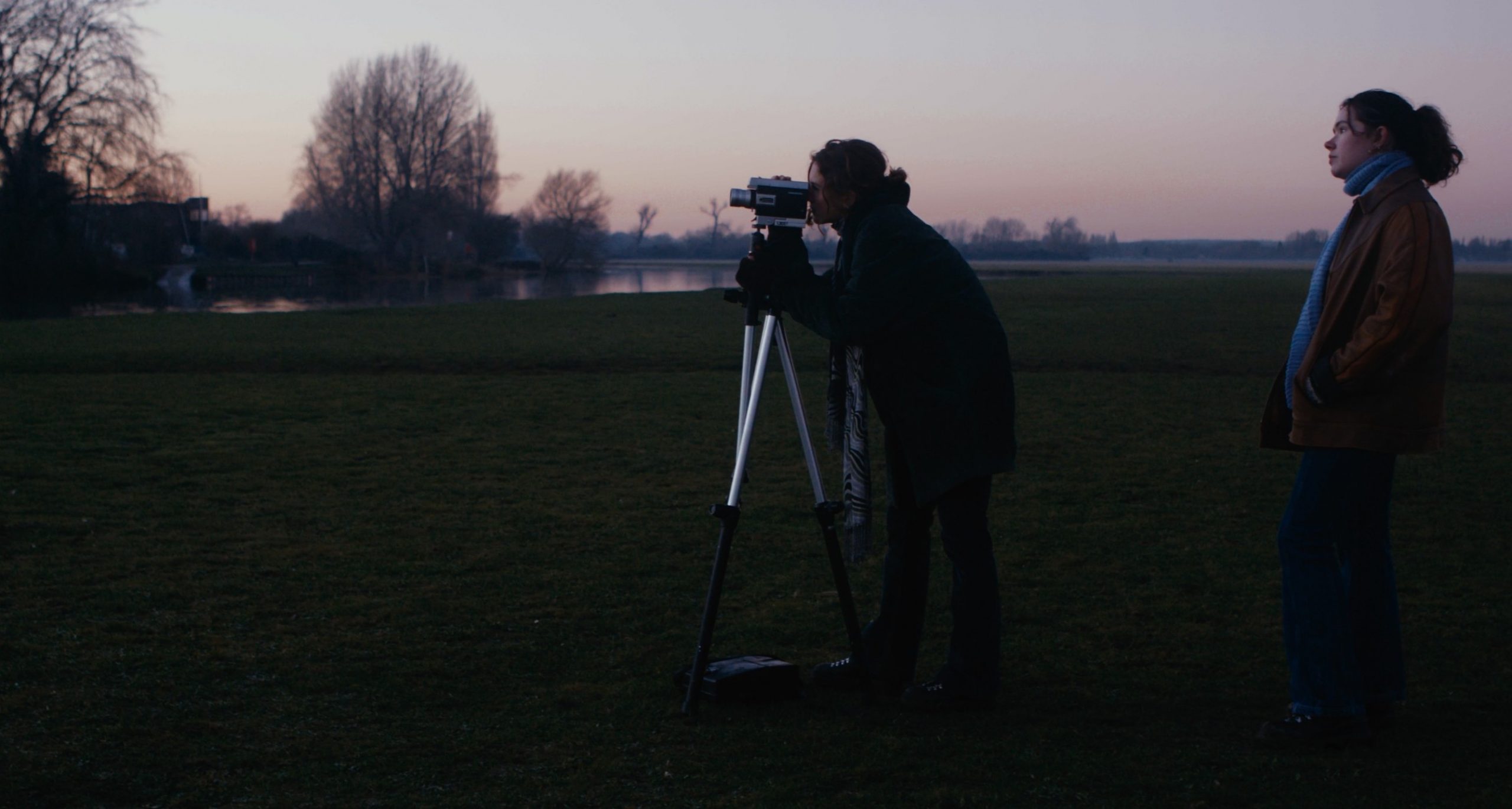
Review: OUFF Short Film Festival 2023
by Anneka Pink, Coco Cottam, Julia Males, Madi Hopper, Seraphina Evans | February 10, 2023
Set 1: Absurd and Experimental (Monday, 30th January)
By Coco Cottam
The first night of OUFF’s Short Film Festival did not disappoint. Themed Absurd and Experimental, each of the four films screened shared a desire to provoke. Personal highlights included DaVinci (Hugo Max and Bora Rex), a film that provides a glimpse into a secret underground club by the Martyr’s Memorial on St. Giles, and Red Ridinghood (Ivan Halpenny), which reimagines the fairy-tale by reversing the roles of the girl and the wolf.
The screening began with the night’s winner, Really (Tamara di Marco), which follows a young woman who wakes up multiple times in her own dream. Rousing to a dark and red-lit bedroom, the woman, played by Gillian Konko, is just as disorientated as we are. The viewer is guided through a trance sequence by an angel, moving from lecture theatre to coffee shop, with all the non-logic of a dream. The film’s strength is in its sumptuous visuals: each shot is woven with paintings of the sun and moon, the stars and sky. This mood is captured in one of the last lines: “No colour, no time, just sun, moon, eyes.” It’s a confident glimpse into what a dream might look like, despite never truly being able to replicate its chaos and illogic. Aside from a few clunky parallels, like the woman waking up and a book by Freud falling out of bed alongside her, the film is an intriguing exploration of the dream world.
What’s Left (Bora Rex) is described in the setlist as “a fractured meditation on the white noise of love and loss.” Voiced by Shaw Worth, the reflection drifts through the inverted black and white outlines of trees: “at once the chord we rely on between people wasn’t there.” Static noise drones over the narrator’s voice as the film drifts between these apocalyptic visions of powerlines and palm trees. It is sensory overload, and at times the visuals are so indistinct they evoke vague images of movement – the outlines of countries on a map or bodies travelling through black space. The short form and digitally ambiguous visuals manage to address themes as broad and intangible as loss, while still maintaining a graceful precision.
Bora Rex and Hugo Max’s DaVinci was cryptically mesmerising. A man floats supine down a construction site corridor, trotting into shot a second later. It’s a quiet film, occasionally interrupted by the screech of a police car or the far-away chatter of drunk club-goers. From out of nowhere, the man gathers a coterie, who utters the code word DaVinci as they spiral down a staircase to a public loo turned mysteriously into a club. The sequences are all left ambiguous, with the final shot ending on a clip of a bird box whirring like security. Just as elusive is the epigraph by Leonardo da Vinci: “I have offended God and mankind because my work didn’t reach the quality it should have.” When I probe Hugo on the nuances of the film, he tells me, “The less said about it the better.” He describes working with Bora as “an exhilarating conversation, like chamber music,” remembering “form[ing] the whole film in one conversation, amalgamating anecdotes and our shared concern with character and atmosphere, locating these ideas in the film’s recognisable and simultaneously unnerving setting.” This process resulted in a film that is at once as impossible as it is knowing – and is definitely worth a watch.
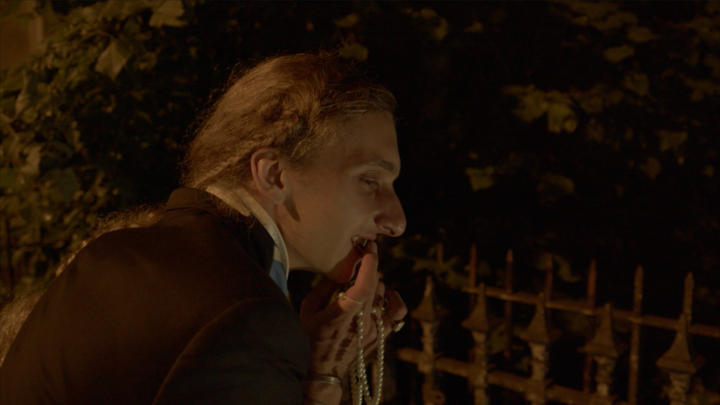
Set 2: Pivotal Moments, Crucial Conversations (Tuesday, 31st January)
By Julia Males
Night two, titled Pivotal Moments, Crucial Conversations, opened with comedy in the face of death. Maude (Rit Anand) was a fun start, painting warm and saturated tones over family squabbles in an assets office. According to its description, the film is about “the ‘death’ of a husband.” These air quotes are deliberate: at one point in the film, the presumably not-deceased husband steps out from behind a curtain. Maude’s cartoonish visuals establish a kind of anti-grief. It is quaint and colourful, with a heartfelt, dreamy, and fluid interlude at its core. The symmetrical framing and whimsical costumes evoke Wes Anderson’s tropes.
Oil Paint (Thomas Vallely) deals with grief, too. One line – “It’s a funeral. You can’t not like someone when they’re dead” – establishes an easy, close honesty between its protagonists, played by Bronte Sherbourne and Gillian Konko. Tasked with eulogising a father she didn’t like much, the film nicely hones in on the moments in the run-up to a funeral. Credits to the composition are deserved: the shots of sisterly tenderness are given just enough time to sit with us. These pauses give the film a quiet weight.
Next was Ana Tezeta (Ana Nedeljkovic), whose simple, thoughtful dialogue was refreshing to watch. The story follows a woman who is sent to clean the house of a dead man she doesn’t seem to know. A slightly nebulous plot is compensated for by a nice meta-cinematic touch, as the protagonist finds an old film camera in the house and leaves with it. Completing the trio of grief films which reject any sense of loss, Tezeta leaves us wondering about legacy and creation.
Lioness (Molly Smith), the second overseas entry of the night, arrived awash with much international acclaim, bringing an American glossiness – and presumably much higher budget – to the selection. A crisp audio mix enables a tense setup, which is brilliantly green, greasy, and nauseating. Yet Lioness has a complete shift at its centre: as daylight comes, it lapses into the morning joy of a child’s birthday. Despite the evening’s theme of Crucial Conversations, this one was almost completely and brilliantly wordless.
Finally, A Fateful Encounter (Tami Olusanya) brings us closer to home, set at a Cowley bus shelter at night. Katie Peachey and Murray Whitaker’s fraught domestic struggle was illuminated by an advertising board. The roar of passing traffic punctuates the dialogue, overwhelming what the audience can hear. Nevertheless, I wonder if this kind of straining to listen has rendered us voyeurs. A Fateful Encounter is tense, terse, and accidentally witnessed.
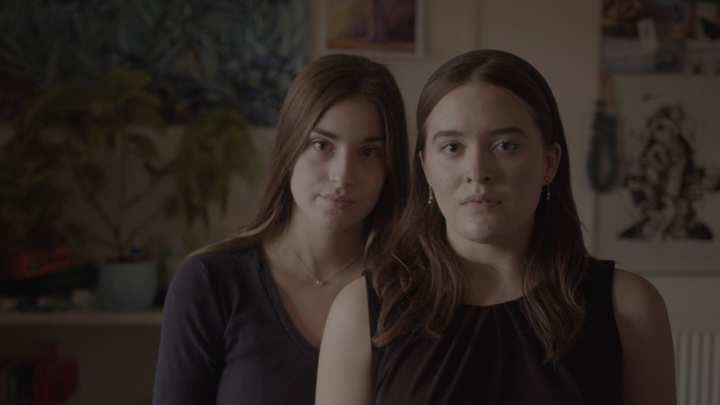
Set 3: Dreamy and Poetic (Wednesday, 1st February)
By Anneka Pink
Initially, OUFF’s sold-out third night, Dreamy and Poetic, seemed to indicate the aesthetic inclination of Oxford students for the romantic. All five films shared a focus on relationships. Et in Arcadia (Robert Daniel), Questions in a World of Blue (Ciana Russo), and A Mosaic of All Possible Greens (Rosie Robinson) stood out for their use of the theme, interrogating the ways through which we view other people.
Et in Arcadia lulls the spectator into the tinted lens of a period drama summer picnic. The decision to shoot at the ruins of Godstow Abbey evokes a pastoral idyll. The two female protagonists – Alice and Edith, sisters – first appear as they are having their picture taken. The dialogue quickly establishes their emotional intimacy and underlines that the outside setting symbolises their desire to escape family expectations. However, their arcadia is ruptured when it becomes clear that Edith is about to be married off. Lying in the lap of her older sister with a white veil over her face, Edith light-heartedly declares, “I am Death.” The bittersweet hope with which she approaches her marriage is soon turned to tragedy by a shift to the present, revealing the sisters’ photo to be the subject of a student’s thesis on literary Victorian women – the events the audience was watching had already long passed. Alice, revealed to have been the inspiration for Lewis Carrol’s novel, never recovers from the grief of Edith’s sudden death weeks before her marriage. The student, played by the same actor as Alice, encounters an entitled boy who, in a voyeuristic fashion, takes a polaroid of her and tells her to break up with her girlfriend, with whom it is assumed she can’t possibly be happy. Surprisingly, she does, believing this to be an expression of individual agency and citing the sisters as an example of the need to live in the present. The audience is not as sure, ending the film on a note of disquiet.
The best film of the night was chosen by the audience, who voted by marbles. By the end of the set, the glass for A Mosaic of All Possible Greens was full. The film’s narrative movingly outlines the limits of escapism. Named after a line in a James Merrill poem, the story follows two friends, Sylvie and Claire, as they record a film to process their grief for their deceased friend Grace. Sylvie hopes to capture a green flash on film, a symbol of a soul gone to heaven. meanwhile, is desperate to attain Sylvie’s affection and learns James Merrill to compete with Sylvie’s love for Grace, though she never succeeds. Their relationship reflects Sylvie’s inability to see beyond her grief, and their reconciliation is essential. Despite Claire’s fears that Sylvie is being consumed by her film, she helps her complete it, and provides a warm presence on the camera. Their film is shot with old-styled film and angel lighting, capturing different locations in Oxford. The audio of their laughter is played over it, and as Sylvie asserts, this is no different from music, a tribute to their friendship as the two grieve together. In the final shot, Sylvie fiddles with the camera in front of the lens, switching it off and providing the audience with the hope that one day she will be able to see the world without it.
The final film of the night, Questions in a World of Blue, tackles our often narcissistic perceptions of others. Starting with strong dialogue and a narrative frame of two girls people-watching from the Independent Café, the action then shifts to a visualisation of the internal monologue of a boy walking by. A beautifully shot and vividly coloured montage follows, as the boy recounts his ill-starred love for a girl in college. Through this sequence, reminiscent of Orlando’s indulgence in the performative acts of the lover in Twelfth Night, the film critiques the romantic perceptions we hold of others. The audience was particularly amused by the second female actor’s criticism of her friend, accusing her of romanticizing the aloof, book-clutching, long hair and rollies type of boys. Ultimately, such ideas of the inner lives of others are revealed to be little more than fantasies.
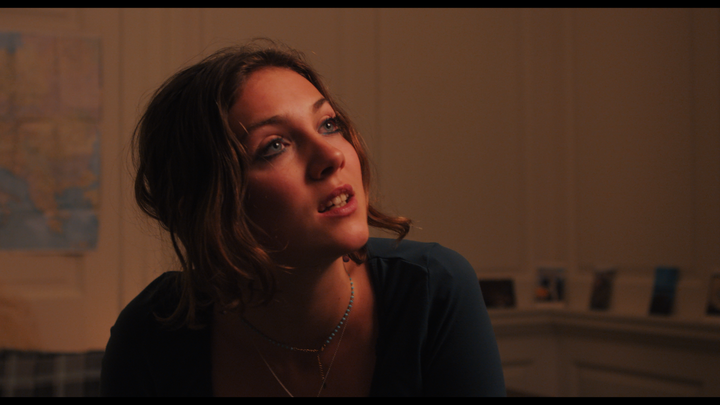
Set 4: Unheard Voices – Documentaries (Thursday, 2nd February)
By Seraphina Evans
There were some truly excellent moments on night four, themed Unheard Voices – Documentaries. The exploration of different techniques was consistently impressive, from still shots to double exposures and slow motion. The combination of engaging subject matter, insightful commentary, accessible themes, and experimental techniques made for a fascinating evening.
The defining shot of the night came from Last Flight from Dollo Ado (Raphael Bradenbrink). A refugee family stand in their new clothes – bought in preparation for their life in Germany – against the backdrop of a refugee camp, complete with goats milling about in the foreground. Bradenbrink’s film was the best of the night, with stunning shots providing insight into a politically-relevant and emotional topic – I turned to my friend at the end of the film to find her with tears in her eyes. Last Flight from Dollo Ado combined insight and excellent cinematography to make a film both unforgettable and well worth watching.
Footnotes (Lily Kershaw) made use of spliced video and audio to emphasise important points, with interviews of her mother and grandmother overlaid on shots of a wintry outdoor scene and Oxford buildings. This technique is executed effectively at the end to highlight the theme of love and family, creating an affecting conclusion that ties together elements of the film which were seemingly separate up until this point. As the cutting between shots and audio picks up pace towards the end, Kershaw achieves a hypnotising effect.
The remaining films were memorable for the distinct feeling they left me with. The Road to Tozeur (Henry Worsley) has a unique warmth to it, described by the creator as “a run-and-gun sort of short film.” Conversations with friendly locals and warm desert scenes create a youthful and intimate atmosphere. Worsley’s inclusion of non-traditionally visually-appealing elements, such as the ferry ride, makes sense when you reach the final destination. The sheer natural beauty of Tozeur is then played off against less glamorous elements of the journey. A film simply about one stunning location would not have felt so real or immersive. Then, in Relámpago (Karol Janiuk), everyday visuals are made charming by the use of black and white. The choice to not have the images fill the whole screen is equally effective, with each shot instead taking a Polaroid-like shape. The film is a touching series of snapshots into the lives of the children at this Colombian school.
I simply couldn’t end this review without an honourable mention to the man from Stoke featured in Home: People or Place? (Khadijah Ali). He provides the first and only comedic relief of the evening, delivering faultless one-liners with a kind of genius. Thank you to Ali for his wit.
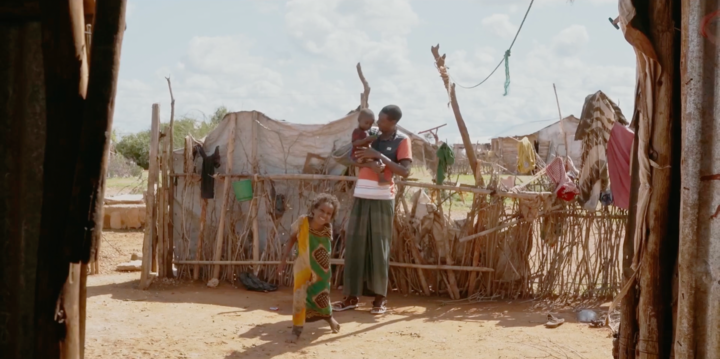
Set 5: The Dark Side of the Screen (Friday, 3rd February)
By Madi Hopper
Rounding off a stellar week of Oxford’s finest short films was Friday’s Dark Side of the Screen category. Although I’m not a person who normally enjoys horror, the variety and ingenuity of the night’s offerings stretched the boundaries of the Dark Side. The best film of the night, provoking raucous laughter from the audience, was Ctrl-Z (Emma Earnshaw), deservedly crowned the winner in Saturday’s awards. It heightens the mundanely toe-curling horror of an awkward first date, following one-half of the couple’s attempt to literally rewrite reality, Wattpad-style. Delivering what was undoubtedly the sharpest dialogue of the night – “We had real chemistry!”; “That was the worst date I’ve ever been on” – the film perfectly captures the universal horror of miscommunication. Its use of Oxford locations brings the familiarity of the dark side of dating closer to home. Bailey Finch-Robinson (Best Leading Actor) orchestrates a darkly hilarious tone, well complimented by Rosie Owen’s increasingly strained attempts to let him down gently.
Another highlight was Absolution (Lauren Spohn), told through a single set and one actor, doubling as both psychoanalyst and patient. The film nonetheless stood out for the clockwork smoothness with which its sound, set, and cinematography combines to create an incredibly unique and effective piece. The editing and cinematography keep the pace lively, whilst the sound design is tense. Anna Marie Fitzgerald’s lush production design was the best of the night, combining mid-century cosiness with a hint of dark academia, creating an intriguingly layered set that remained eye-catching throughout, with the camera sporadically picking out details – a china dog, a filling ashtray – for the audience’s benefit.
Among the rest of the films, Venom: Mark the Date (Nidhi Madhani) deserves recognition for its innovative use of the humble vape as a comedic prop – outshining the rather weak performance of the male lead – and Zara (Emma Smith), for its gorgeous editing, though the plot and characters are of a filthy-rich-spoilt-rotten ilk that felt clichéd and dated. Overall, though, the diversity of the entrants made it a perfect end to the week, providing a splendid celebration of Oxford’s student film. ∎
